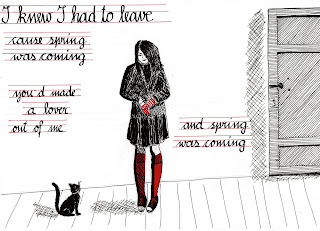
Last night, I watched Vera Chytilová's "Sedmikrásky". I've heard so much about this film before, knowing that this is a classic of the Czech nouvelle vague, and I've been wanting to see it for ages, but it is extremely rare and hard to get hold of, unless you understand the Czech language (an original DVD without subtitels is easily available in the Czech Republic). In fact, it is much easier here to get a 35mm film copy than a DVD, and I'm proud of the cinema I work at, the UT Connewitz, for taking the chance and showing this extremely rare classic. (The bizarre experience of trying to be a normal guest in a cinema I know only too well - including all the little technical problems that can occur in a very old film theatre with very old technical equipment - was also highly interesting. But this is another story worth an entry of its own!)
As for Chytilová's film, I had high expectations, and as I love a couple of films of the French nouvelle vague, I imagined this one as something like a Czech version of Rivette's masterpiece "Celine et Julie vont en bateau" - two girls who need no one but each other and their own imagination to have a whole lot of fun. And yes, indeed, this comparison is quite fitting, though the two protagonists in "Sedmikrásky" even push things a bit further. One could describe it as "Celine and Julie have a real binge", or something like that. The two girls - both named Marie - recognise that the whole world is spoiled and therefore decide to become spoiled as well. They start to live a life in excessive hedonism, they play their games with other people (mainly guys), eat a lot and just have fun, no matter what the consequences are. And it is definitely fun to watch that, though there is a lot more to it: the hedonist surface does reveal a subversive message (the film was forbidden for a year or so under the communist government). At the time of its release, it was unusual enough that girls amused themselves as if it was the most natural thing in the world. Today, this might appear quite normal, but in the pre-sexual-revolution 1960s and under a totalitarian regime, this was a statement in itself. Apart from this, the matter-of-factness in the girls' behaviour of exceeding all boundaries, still bears a subversive, anarchist touch, even in our modern times. Everything is possible - that's probably what Chytilová wants to show us, and in these terms, the film is highly encouraging.

There is much more to discover in the dialogues. For example, when the two Maries go to a little village where the locals don't pay any attention to them, they begin to wonder if they really exist at all, before they discover the mess of leaves and other things they've spread all along the river shores and come to the conclusion that they MUST exist - a conclusion that leads them to an outburst of euphoria. Once can interpret dialogues like that in many ways, including the position of women in society in general: being constantly overlooked or ignored. This, to name just one example... Another thing I definitely have to mention is the visual appeal of this movie. The style is very experimental, with changes in colour, unusual compositions of objects in the picture, fast cuts and the like. A couple of times I asked myself: was this really filmed in 1966? Sometimes it looked a lot like experimental films or video clips from our days, so one could say, Chytilová clearly was ahead of her times aesthetically, having used some techniques long before they were common. I think I still have to reflect over some things for a bit longer, and possibly watch the film again as there are so many little details to discover...


